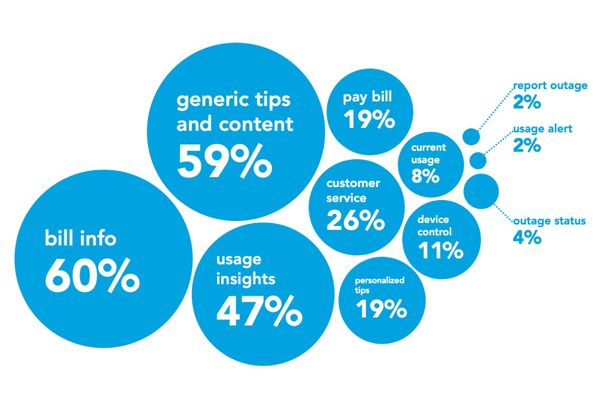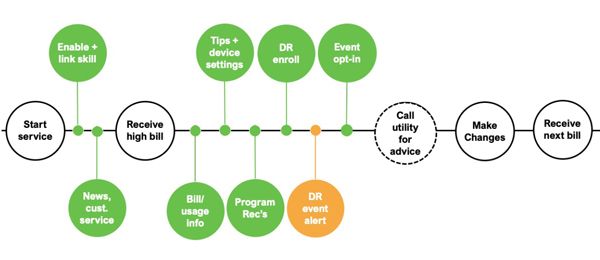
Voice 101 for utilities: Alexa, how can voice apps engage consumers?
Voice assistants are opening new doors to build customer relationships, but utilities need a holistic strategy before diving into app development.
Utilities have made tremendous strides in refining their customer engagement strategies in recent years, fully embracing modern outreach channels like social media. With the explosive growth of smart speakers and voice assistants across the world, utilities are pursuing voice as the newest channel for engagement.
Utility voice apps built for Alexa and Google Assistant are delivering personalized insights, bill information, program recommendations, and more—increasing customer engagement and contributing to revenue generation. Utilities are even creating distinct apps in the languages most common to their service territories, ensuring that non-English speakers feel included and considered.
But apps are just a small portion of the bigger voice universe. As part of their overall voice strategies, companies are building custom voice assistants, enhancing or even replacing cumbersome interactive voice response systems (IVRs) with conversational artificial intelligence (AI), defining their sonic branding, and optimizing their content for voice search. In order to stay relevant to an increasingly voice-centric digital space, utilities need the resources to navigate these and other voice-related concerns.
Smart speakers and smartphones
Smart speakers and voice assistants have the power to work a brand’s presence into consumers’ daily lives. New articles are published daily that tout the popularity of smart speakers and emphasize their potential impact on consumer habits.
Smart speaker adoption rates are unprecedented among recent consumer electronic innovations, with U.S. smart speaker ownership rising to 76 million in the second quarter of 2019. But pundits often fail to highlight that voice apps built for Alexa, Google Assistant, and Bixby are also accessible via smartphone. 146.6 million Americans have tried voice assistants on smartphones, and nearly one in four use the voice assistant on their mobile phones daily.
Billions of devices in-hand translate to countless opportunities for brands to engage their customers. And customers eligible for utility assistance based on income—who are more likely than other customers to rely on smartphones for Internet access—have equal access to voice apps as those who have smart speakers and strong wifi at home.
Regardless of whether interactions take place on a smart speaker or a smartphone, consumers expect brands to have an active presence in the voice space. Companies that meet these expectations experience higher customer satisfaction and stickiness.
The likelihood of a customer to become loyal to a brand and recommend it to others is measured via Net Promoter Score (NPS), a metric adopted by more than two-thirds of Fortune 1000 companies. A recent Capgemini Research Institute study showed that providing a voice interface elevates a brand’s NPS by nearly 20 points for voice assistant users. When brands meet their customers wherever they are, including the voice space, they are rewarded with customers who share their positive experiences with others.
Every company needs a voice strategy
To take advantage of this unprecedented level of access to consumer attention, companies may be tempted to immediately launch into development of a voice app pilot. But creating voice apps outside of the context of a coordinated strategy can result in orphaned applications once pilots conclude.
Utilities need to create a voice strategy that defines exactly how voice fits into their overall customer engagement approach and supports their goals. It should include input from a variety of utility stakeholders, voice subject matter experts (SMEs), and trusted utility advisors.
To kick off voice strategy creation, we advise utilities to hold design thinking-based workshops for stakeholders. These exercises establish a baseline understanding of voice concepts, vet voice as a valid means of supporting organizational goals, and obtain executive buy-in and permission to proceed. This work sets the stage for more in-depth discovery and definition via design sprints, yielding an actionable strategy with stakeholder support—as well as voice app prototypes to test with customers or via third party service for larger public feedback.
Voice apps are a great first step
Creating an app for the Amazon and Google platforms is often a key component of a utility voice strategy. But knowing exactly what content to provide can be tricky. We surveyed 1,000+ new home buyers who are customers of five different utilities in four states about their preferences around smart home technology. Their responses yielded great insight into how customers want to use utility voice apps.
When asked about the usefulness of hearing about certain utility-related topics via voice, customers responded as follows.
- 44% indicated an interest in receiving high bill notifications
- 39% wanted to hear ways to lower their next bill
- 36% would like information about their anticipated electric bill
- 34% wanted to hear a comparison of their usage to similar homes
- 32% were interested in hearing energy-saving tips
- 31% were interested in hearing about energy efficiency programs
Utilities are embracing apps as a first step in establishing their voice presence, but to date, these apps only embody a fraction of the engagement potential of in-home voice assistants. They are not fully meeting the information interests above.
In an informal survey of electric and gas voice apps for Alexa and Google Assistant worldwide, ICF found that functionality centers on billing and generic tips, while about half provide personalized energy insights. About one-fifth of apps offer bill pay functionality, and only a few allow users to set alerts.

ICF experts are currently exploring new ways to use voice apps to enhance the customer journey and generate revenue. We believe that the greatest potential for voice apps is to support customer engagement and enhance the customer’s experience with their utility.
As illustrated in the example below, a combination of pull content and push alerts from a voice app could help customers resolve high bill issues without requiring call center involvement.

Alerts based on real-time monitoring can provide proactive calls-to-action, while full libraries of behavioral energy tips and program recommendations can offer a wealth of self-service opportunities — empowering customers to make significant adjustments to usage and sign up for money- and energy-saving programs.
There are similar opportunities for voice to enhance the experience of energy efficiency program participants, such as:
- Make, change, and cancel appointments for direct install and appliance recycling programs
- Check their eligibility to receive and then request delivery of energy kits
- Opt-in or out of demand response events
- Hear reminders about rate fluctuations, bill due dates, and other events
- Earn points for gameplay or other app interactions and redeem rewards
- Receive codes to make discounted purchases at online utility marketplaces
In order to help utilities establish their presence in the voice space, ICF has created a white-label Alexa skill (and soon-to-be Google Assistant action) that includes a baseline of expected voice app functionality. We have also developed APIs that deliver ICF Sightline™-generated personalized energy insights, Next Best Offer program recommendations, and program participation updates.
If a utility has already invested in a smart home voice app, ICF is exploring ways to integrate existing apps with our software to combine functionality and strengths into a single, branded experience. We can also develop custom voice assistants, enterprise voice apps for corporate scheduling and conference room management, and other voice integrations as needed.
If you build it…They may not come
While building an app is a key component of a winning voice strategy, your customers will need help discovering your offering. Both your apps and your existing digital content will need to be optimized in order to successfully surface brand information via voice search.
Customers are already interacting with your brand via voice assistant even if you don’t have an Alexa or Google or Bixby voice app. Typically 98% or more of the content delivered in response to a brand inquiry comes from Wikipedia, Yelp, or another third-party source.
Also, deploying and marketing a voice app presents its own unique challenges, especially when potential users are unsure about the value a voice app might bring. App users may not recall available functionality from use to use, and may need to be reminded—both within and outside the app—of the features offered.
ICF recommends a full-service marketing approach to ensure that voice apps are discoverable. Utilities need awareness and outreach campaigns to introduce the voice strategy and apps to the right customers via high-conversion platforms.
Beyond Amazon and Google: Custom voice assistants, chatbots, and sonic branding
Companies are getting smarter about how voice apps can enhance customer outreach and relieve burden on utility call centers. But just like a brand’s online presence encompasses more than a website, a company’s voice strategy needs to include more than voice apps.
Enterprises are increasingly choosing to build their own custom voice assistants to create fully optimized and personalized user experiences outside of the Amazon and Google horse race. This allows them to maintain control of the customer relationship, data, and brand. Bank of America, BBC, and IKEA have invested in custom voice assistants, with many more companies expected to follow. Utilities may want to consider whether developing a custom voice assistant or building on the Amazon or Google platforms is the best way to support the customer experience.
Organizations are also enhancing or replacing their IVRs with AI. Gartner predicts that by 2021, 15% of all customer service interactions will be handled entirely by AI, an increase of 400% from 2017. McDonald’s plans to build AI into their drive-through ordering process to improve speech recognition and customer experience. Likewise, utilities should consider doing away with limiting and often frustrating voice menus in favor of open-ended, conversational AI solutions—allowing customers to more quickly obtain issue resolution.
Sonic branding is another investment on the horizon. It ensures that the sounds made by hardware, the songs played in retail locations, and even the music the CEO walks out on stage to for speeches all align with their brand. In the current voice-first era, voice strategy needs to keep the overall brand in mind. This can define the opening bars of a company’s podcast, the theme music that plays when the voice app starts up, and even the actor selected as the voice of their virtual assistants.
How to get started
Utilities have an expansive opportunity to enhance their customers’ experience via voice but may not know where or how to address all of the facets of a successful voice strategy. Often, a partnership with a team of experienced experts is the best way forward.
Few companies, including utilities, have the internal capabilities to devise and launch a voice strategy. By collaborating with a consulting team, utilities can benefit from deep expertise in voice strategy and technology in the energy space. With the right support, you can define, develop, and activate successful voice technology to benefit customers and business goals — keeping your engagement efforts on the cutting-edge of the industry.